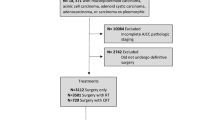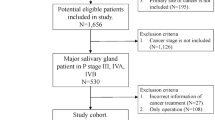Abstract
Purpose
To explore the clinical characteristics, prognostic factors, and value of adjuvant therapy for major salivary duct carcinoma (SDC).
Methods
Data of SDC patients who received surgery was obtained from Surveillance, Epidemiology, and End Results (SEER) database (2004–2016). Kaplan–Meier and Cox regression analyses were performed to assess prognostic factors. Propensity score matching (PSM) was done to evaluate the clinical value of adjuvant therapy.
Results
A total of 287 patients were enrolled. The 5-year overall survival (OS) and disease-specific survival (DSS) rates were 53.8% and 70.8%, respectively. In the univariate analysis, tumor size, T, N, TNM staging, SEER combined staging, number of regional lymph nodes examined, and number of positive lymph nodes were associated with OS and DSS. Age and primary surgical methods were also related to OS. Among patients with negative lymph nodes, patients with tumor size > 4 cm had significantly worse prognosis (P = 0.009). Multivariate analysis showed that age > 75 years, T3–4, and positive lymph nodes were independent risk factors for SDC. After PSM, the prognostic factors were age, tumor site, and T and N stage. Postoperative radiotherapy could improve OS in patients with tumor size > 4 cm (P = 0.049).
Conclusions
Advanced age, submandibular gland lesions, T3–4 stage, and lymph node involvement were independent prognostic factors for SDC. In patients with tumors > 4 cm, adjuvant radiotherapy improved the OS of SDC patients.



Similar content being viewed by others
Availability of data and materials
Not available.
Abbreviations
- SDC:
-
Salivary duct carcinoma
- SGCs:
-
Salivary gland cancers
- SEER:
-
Surveillance, epidemiology, and end results
- PSM:
-
Propensity score matching
- OS:
-
Overall survival
- DSS:
-
Disease-specific survival
- HR:
-
Risk ratio
- CI:
-
Confidence interval
- PSM:
-
Propensity score matching
References
Laurie SA, Licitra L (2006) Systemic therapy in the palliative management of advanced salivary gland cancers. J Clin Oncol 24(17):2673–2678. https://doi.org/10.1200/jco.2005.05.3025
Rahman M, Griffith CC (2021) Salivary duct carcinoma: an aggressive salivary gland carcinoma with morphologic variants, newly identified molecular characteristics, and emerging treatment modalities. Surg Pathol Clin 14(1):111–126. https://doi.org/10.1016/j.path.2020.09.010
Keller G, Steinmann D, Quaas A, Grünwald V, Janssen S, Hussein K (2017) New concepts of personalized therapy in salivary gland carcinomas. Oral Oncol 68:103–113. https://doi.org/10.1016/j.oraloncology.2017.02.018
Nakaguro M, Tada Y, Faquin WC, Sadow PM, Wirth LJ, Nagao T (2020) Salivary duct carcinoma: updates in histology, cytology, molecular biology, and treatment. Cancer Cytopathol 128(10):693–703. https://doi.org/10.1002/cncy.22288
Park YM, Kang MS, Kim DH, Koh YW, Kim SH, Lim JY, Choi EC (2020) Surgical extent and role of adjuvant radiotherapy of surgically resectable, low-grade parotid cancer. Oral Oncol 107:104780. https://doi.org/10.1016/j.oraloncology.2020.104780
Fitzpatrick PJ, Theriault C (1986) Malignant salivary gland tumors. Int J Radiat Oncol Biol Phys 12(10):1743–1747. https://doi.org/10.1016/0360-3016(86)90314-7
Renehan AG, Gleave EN, Slevin NJ, McGurk M (1999) Clinico-pathological and treatment-related factors influencing survival in parotid cancer. Br J Cancer 80(8):1296–1300. https://doi.org/10.1038/sj.bjc.6990501
Terhaard CH, Lubsen H, Rasch CR, Levendag PC, Kaanders HH, Tjho-Heslinga RE, van Den Ende PL, Burlage F (2005) The role of radiotherapy in the treatment of malignant salivary gland tumors. Int J Radiat Oncol Biol Phys 61(1):103–111. https://doi.org/10.1016/j.ijrobp.2004.03.018
Terhaard CH, Lubsen H, Van der Tweel I, Hilgers FJ, Eijkenboom WM, Marres HA, Tjho-Heslinga RE, de Jong JM, Roodenburg JL (2004) Salivary gland carcinoma: independent prognostic factors for locoregional control, distant metastases, and overall survival: results of the Dutch head and neck oncology cooperative group. Head Neck 26(8):681–692. https://doi.org/10.1002/hed.10400
Stodulski D, Mikaszewski B, Majewska H, Kuczkowski J (2019) Parotid salivary duct carcinoma: a single institution’s 20-year experience. Eur Arch Otorhinolaryngol 276(7):2031–2038. https://doi.org/10.1007/s00405-019-05454-0
Kantamani D, Bandaru SS, Miatech JL, Stagg MP (2021) Salivary duct carcinoma: case reports and brief review of the literature. Case Rep Oncol Med. https://doi.org/10.1155/2021/2672772
Haderlein M, Scherl C, Semrau S, Lettmaier S, Hecht M, Erber R, Iro H, Fietkau R, Agaimy A (2017) Impact of postoperative radiotherapy and HER2/new overexpression in salivary duct carcinoma: a monocentric clinicopathologic analysis. Strahlenther Onkol 193(11):961–970. https://doi.org/10.1007/s00066-017-1196-8
Salovaara E, Hakala O, Bäck L, Koivunen P, Saarilahti K, Passador-Santos F, Leivo I, Mäkitie AA (2013) Management and outcome of salivary duct carcinoma in major salivary glands. Eur Arch Otorhinolaryngol 270(1):281–285. https://doi.org/10.1007/s00405-012-1997-4
Breinholt H, Elhakim MT, Godballe C, Andersen LJ, Primdahl H, Kristensen CA, Bjørndal K (2016) Salivary duct carcinoma: a Danish national study. J Oral Pathol Med 45(9):664–671. https://doi.org/10.1111/jop.12426
Jayaprakash V, Merzianu M, Warren GW, Arshad H, Hicks WL Jr, Rigual NR, Sullivan MA, Seshadri M, Marshall JR, Cohan DM, Zhao Y, Singh AK (2014) Survival rates and prognostic factors for infiltrating salivary duct carcinoma: analysis of 228 cases from the Surveillance, Epidemiology, and End Results database. Head Neck 36(5):694–701. https://doi.org/10.1002/hed.23350
El-Naggar AK, Chan JK, Grandis JR (2017) WHO classification of head and neck tumours
Villepelet A, Lefèvre M, Verillaud B, Janot F, Garrel R, Vergez S, Bertolus C, Malard O, de Gabory L, Mauvais O, Baujat B (2019) Salivary duct carcinoma: prospective multicenter study of 61 cases of the Réseau d’Expertise Français des Cancers ORL Rares. Head Neck 41(3):584–591. https://doi.org/10.1002/hed.25194
Boon E, Bel M, van Boxtel W, van der Graaf WTA, van Es RJJ, Eerenstein SEJ, Baatenburg de Jong RJ, van den Brekel MWM, van der Velden LA, Witjes MJH, Hoeben A, Willems SM, Bloemena E, Smit LA, Oosting SF, Jonker MA, Flucke UE, van Herpen CML (2018) A clinicopathological study and prognostic factor analysis of 177 salivary duct carcinoma patients from The Netherlands. Int J Cancer 143(4):758–766. https://doi.org/10.1002/ijc.31353
Otsuka K, Imanishi Y, Tada Y, Kawakita D, Kano S, Tsukahara K, Shimizu A, Ozawa H, Okami K, Sakai A, Sato Y, Ueki Y, Sato Y, Hanazawa T, Chazono H, Ogawa K, Nagao T (2016) Clinical outcomes and prognostic factors for salivary duct carcinoma: a multi-institutional analysis of 141 patients. Ann Surg Oncol 23(6):2038–2045. https://doi.org/10.1245/s10434-015-5082-2
Mahmood U, Koshy M, Goloubeva O, Suntharalingam M (2011) Adjuvant radiation therapy for high-grade and/or locally advanced major salivary gland tumors. Arch Otolaryngol Head Neck Surg 137(10):1025–1030. https://doi.org/10.1001/archoto.2011.158
Lewis AG, Tong T, Maghami E (2016) Diagnosis and management of malignant salivary gland tumors of the parotid gland. Otolaryngol Clin North Am 49(2):343–380. https://doi.org/10.1016/j.otc.2015.11.001
Haderlein M, Scherl C, Semrau S, Lettmaier S, Hecht M, Putz F, Iro H, Agaimy A, Fietkau R (2019) Salivary gland carcinoma (SGC) with perineural spread and/or positive resection margin—high locoregional control rates after photon (chemo) radiotherapy—experience from a monocentric analysis. Radiat Oncol 14(1):68. https://doi.org/10.1186/s13014-019-1260-x
Lee DS, Lee CG, Keum KC, Chung SY, Kim T, Wu HG, Kim JH, Sung MW, Ahn SH, Cho KH, Kang KM, Oh YT, Kim JH, Kang MK (2020) Treatment outcomes of patients with salivary duct carcinoma undergoing surgery and postoperative radiotherapy. Acta Oncol 59(5):565–568. https://doi.org/10.1080/0284186x.2020.1730005
Bernier J, Domenge C, Ozsahin M, Matuszewska K, Lefèbvre JL, Greiner RH, Giralt J, Maingon P, Rolland F, Bolla M, Cognetti F, Bourhis J, Kirkpatrick A, van Glabbeke M (2004) Postoperative irradiation with or without concomitant chemotherapy for locally advanced head and neck cancer. N Engl J Med 350(19):1945–1952. https://doi.org/10.1056/NEJMoa032641
Schoenfeld JD, Sher DJ, Norris CM Jr, Haddad RI, Posner MR, Balboni TA, Tishler RB (2012) Salivary gland tumors treated with adjuvant intensity-modulated radiotherapy with or without concurrent chemotherapy. Int J Radiat Oncol Biol Phys 82(1):308–314. https://doi.org/10.1016/j.ijrobp.2010.09.042
Cho JK, Lim BW, Kim EH, Ko YH, Oh D, Noh JM, Ahn YC, Baek KH, Jeong HS (2016) Low-grade salivary gland cancers: treatment outcomes, extent of surgery and indications for postoperative adjuvant radiation therapy. Ann Surg Oncol 23(13):4368–4375. https://doi.org/10.1245/s10434-016-5353-6
Tanvetyanon T, Fisher K, Caudell J, Otto K, Padhya T, Trotti A (2016) Adjuvant chemoradiotherapy versus with radiotherapy alone for locally advanced salivary gland carcinoma among older patients. Head Neck 38(6):863–870. https://doi.org/10.1002/hed.24172
Cheraghlou S, Schettino A, Zogg CK, Otremba MD, Bhatia A, Park HS, Osborn HA, Mehra S, Yarbrough WG, Judson BL (2019) Adjuvant chemotherapy is associated with improved survival for late-stage salivary squamous cell carcinoma. Laryngoscope 129(4):883–889. https://doi.org/10.1002/lary.27444
Acknowledgements
The authors acknowledge the efforts of the SEER Program tumor registries in the creation of the SEER database and thank all the patients analyzed in this study.
Funding
None to declare.
Author information
Authors and Affiliations
Contributions
All authors conceived and designed the study. DZ and LL analyzed data and wrote the paper, and FM make suggestion and revised the paper. All authors have read and agreed to the published version of the manuscript.
Corresponding author
Ethics declarations
Conflict of interest
The authors declare that they have no competing interests.
Ethics approval and consent to participate
Not available.
Consent for publication
Yes.
Additional information
Publisher's Note
Springer Nature remains neutral with regard to jurisdictional claims in published maps and institutional affiliations.
Supplementary Information
Below is the link to the electronic supplementary material.
405_2022_7599_MOESM2_ESM.pdf
Supplementary file2 Positive lymph nodes and survival in SDC patients. a: Positive regional lymph nodes are plotted against the total number of regional lymph nodes in SDC who underwent neck dissection; b: Relationship between tumor size, tumor grade, and lymph node involvement; c, d: Kaplan–Meier estimate for OS and DSS. d (PDF 106 KB)
405_2022_7599_MOESM4_ESM.docx
Supplementary file4 Univariate and multivariate analyses for OS after PSM in the surgery alone and postoperative radiotherapy groups. (DOCX 18 KB)
405_2022_7599_MOESM5_ESM.docx
Supplementary file5 Univariate and multivariate analyses for OS after PSM in the postoperative radiotherapy and postoperative chemoradiotherapy groups. (DOCX 18 KB)
Rights and permissions
Springer Nature or its licensor holds exclusive rights to this article under a publishing agreement with the author(s) or other rightsholder(s); author self-archiving of the accepted manuscript version of this article is solely governed by the terms of such publishing agreement and applicable law.
About this article
Cite this article
Zhang, D., Li, L., Wen, T. et al. Clinical value of adjuvant therapy on the prognosis of ductal carcinoma of the major salivary gland: a large-scale cohort study. Eur Arch Otorhinolaryngol 280, 409–417 (2023). https://doi.org/10.1007/s00405-022-07599-x
Received:
Accepted:
Published:
Issue Date:
DOI: https://doi.org/10.1007/s00405-022-07599-x




